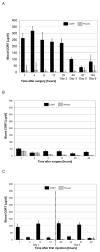Influence of postnatal glucocorticoids on hippocampal-dependent learning varies with elevation patterns and administration methods
- PMID: 28545908
- PMCID: PMC5540754
- DOI: 10.1016/j.nlm.2017.05.010
Influence of postnatal glucocorticoids on hippocampal-dependent learning varies with elevation patterns and administration methods
Abstract
Recent interest in the lasting effects of early-life stress has expanded to include effects on cognitive performance. An increase in circulating glucocorticoids is induced by stress exposure and glucocorticoid effects on the hippocampus likely underlie many of the cognitive consequences. Here we review studies showing that corticosterone administered to young rats at the conclusion of the stress-hyporesponsiveness period affects later performance in hippocampally-mediated trace eyeblink conditioning. The nature and even direction of these effects varies with the elevation patterns (level, duration, temporal fluctuation) achieved by different administration methods. We present new time course data indicating that constant glucocorticoid elevations generally corresponded with hippocampus-mediated learning deficits, whereas acute, cyclical elevations corresponded with improved initial acquisition. Sensitivity was greater for males than for females. Further, changes in hippocampal neurogenesis paralleled some but not all effects. The findings demonstrate that specific patterns of glucocorticoid elevation produced by different drug administration procedures can have markedly different, sex-specific consequences on basic cognitive performance and underlying hippocampal physiology. Implications of these findings for glucocorticoid medications prescribed in childhood are discussed.
Keywords: Development; Eyeblink conditioning; Glucocorticoids; Hippocampus; Neurogenesis; Sex differences; Trace conditioning.
Copyright © 2017 Elsevier Inc. All rights reserved.
Figures








References
-
- Abelson KSP, Fard SS, Nyman J, Goldkuhl R, Hai J. Distribution of [3H]-corticosterone in urine, feces and blood of male Sprague-Dawley rats after tail vein and jugular vein injections. in vivo. 2009;23:381–386. - PubMed
-
- Abercrombie HC, Kalin NH, Thurow ME, Rosenkranz MA, Davidson RJ. Cortisol variation in humans affects memory for emotionally laden and neutral information. Behavioral Neuroscience. 2003;117:505–16. - PubMed
-
- Agnew-Blais J, Danese A. Childhood maltreatment and unfavourable clinical outcomes in bipolar disorder: a systematic review and meta-analysis. Lancet Psychiatry. 2016;3:342–349. - PubMed
-
- Aisa B, Tordera R, Lasheras B, De Río J, Ramírez MJ. Cognitive impairment associated to HPA axis hyperactivity after maternal separation in rats. Psychoneuroendocrinology. 2007;32:256–266. - PubMed
Publication types
MeSH terms
Substances
Grants and funding
LinkOut - more resources
Full Text Sources
Other Literature Sources

